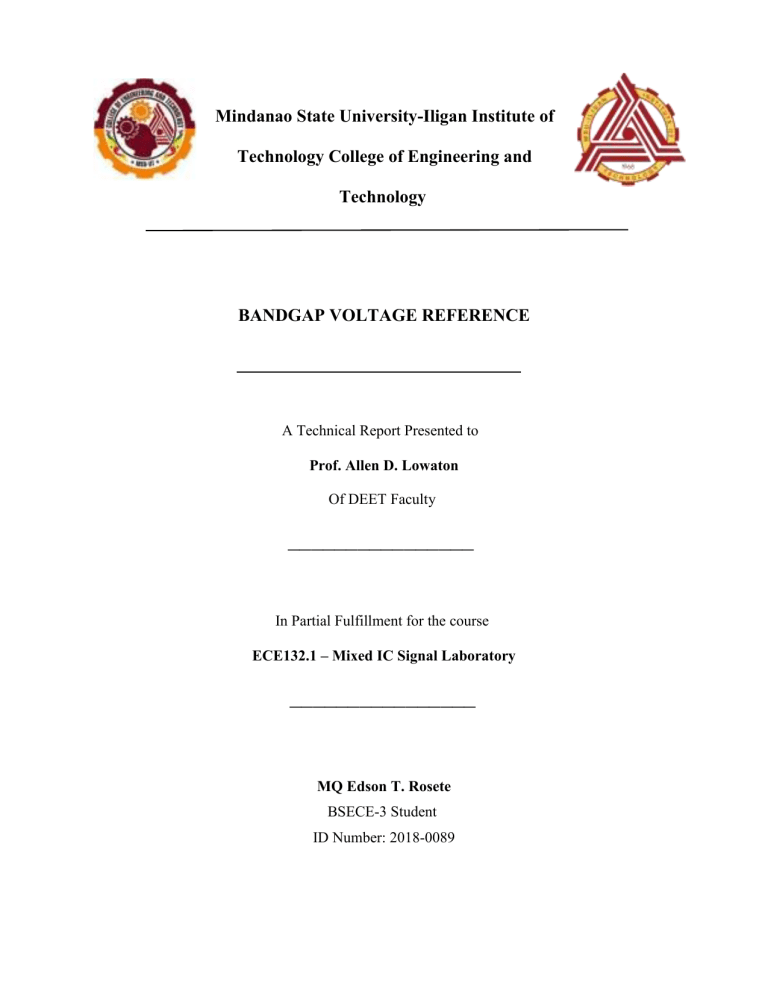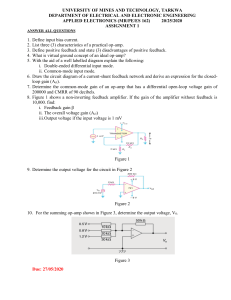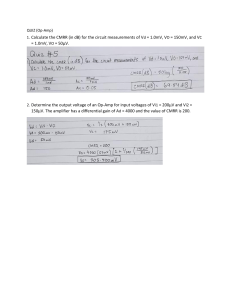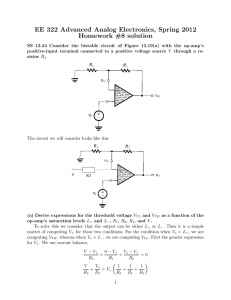
Mindanao State University-Iligan Institute of Technology College of Engineering and Technology BANDGAP VOLTAGE REFERENCE A Technical Report Presented to Prof. Allen D. Lowaton Of DEET Faculty ________________ In Partial Fulfillment for the course ECE132.1 – Mixed IC Signal Laboratory ________________ MQ Edson T. Rosete BSECE-3 Student ID Number: 2018-0089 INTRODUCTION In designing voltage or current references, one important property that must be present is its independence to power supply or temperature variations. This is because the reference circuit is basically the anchor of the whole circuit; if slight changes were to occur, it would mean that the circuit would not behave in the expected manner. In the previous lab activity, the constant gm current reference was designed. One desirable quality of the constant gm current reference is its immunity to power supply variations. However, it is still susceptible to temperature variations. Thus, a reference circuit must be made that is immune to both power supply and temperature variations. That is where the bandgap voltage reference comes into the picture. What makes the bandgap voltage reference immune to temperature variations is the presence of the BJT’s in the circuit. The figure below shows a bandgap voltage reference circuit. Figure 1 – Bandgap Voltage Reference Circuit OBJECTIVES To design a bandgap voltage reference using HSPICE software To compare the performance of a bandgap voltage reference circuit when using an ideal operational amplifier and a non-ideal operational amplifier To simulate the bandgap voltage reference across all process corners MATERIALS NEEDED Personal Computer/Laptop HSPICE Software PROCEDURES The procedures will be the same for both the bandgap voltage reference with an ideal op-amp and the bandgap voltage reference with a non-ideal op-amp Step 1: Simulate the bandgap voltage reference circuit shown in figure 1 in HSPICE. Set the values of R1, R2, and R3 to 7 kΩ. Step 2: Observe and record the changes in the base-emitter voltage (VBE1) with respect to room temperature. Step 3: Observe the changes in the voltage across R3 (VR3) with respect to room temperature. Step 4: Observe the changes in VREF with respect to the changing temperature. Step 5: Calculate the temperature coefficient. Step 6: Calculate the proper values of R1, R2, and R3. Step 7: Re-simulate using the new values of R1, R2, and R3. Step 8: Observe the changes in VREF with respect to the changing temperature across the three different process corners. Step 9: Calculate the temperature coefficient. Step 10: Calculate the sensitivity of VREF to VDD. Step 11: Compare the results of the simulations with a bandgap voltage reference using an ideal op-amp to one using a non-ideal op-amp. RESULTS AND DISCUSSION First, the circuit was coded in HSPICE software based on the diagram shown in Figure 1. Initially, the values of R1, R2, and R3 are set to 7 kΩ. The figures below show the HPSICE Code for the bandgap voltage reference using an ideal op-amp and an actual op-amp. Figure 2 – HSPICE Code for Bandgap Voltage Reference using Ideal Op-Amp Figure 3 – HSPICE Code for Bandgap Voltage Reference using Actual Op-Amp Once the HSPICE Code is finished, simulations are then done. Using AVANWAVES, the changes in the base-emitter voltage (VBE1), the voltage across R3 (VR3), and VREF are then observed with respect to room temperature (for VBE1 AND VR3) and to the changing temperature (for VREF). SIMULATION RESULTS FOR IDEAL OP-AMP: Figure 4 – Change of VBE1 with respect to room temp. Figure 5 – Change of VR3 with respect to room temp. Figure 6 – Change of VREF with respect to temp. SIMULATION RESULTS FOR ACTUAL OP-AMP: Figure 7 - Change of VBE1 with respect to room temp. Figure 8 - Change of VR3 with respect to room temp. Figure 8 - Change of VREF with respect to temp. After simulation of the circuits, their respective temperature coefficients were then calculated using the following equation: 𝑇. 𝐶. = Ideal Op-Amp 𝑉𝑟𝑒𝑓𝑚𝑎𝑥 − 𝑉𝑟𝑒𝑓𝑚𝑖𝑛 𝑇𝑒𝑚𝑝. 𝑆𝑤𝑒𝑒𝑝 × 𝑉𝑟𝑒𝑓 @ 27°𝐶 Actual Op-Amp Figure 9 – Temperature Coefficient for Ideal and Actual Op-Amp From the calculations, it can be seen that the bandgap voltage reference with the actual opamp has the higher temperature coefficient. This is because the op-amp used already contains actual MOS devices, each having their own non-idealities that they contribute to the circuit. The former has a lower temperature coefficient since it uses an ideal op-amp. However, both temperature coefficients are still quite high and need to be lowered to a more acceptable level. In order to accomplish this, the value of R1, R2, and R3 have to be adjusted accordingly. The relation below is used to find the appropriate values of these resistors. 𝑉𝑟𝑒𝑓 = 𝑉𝐵𝐸1 + 𝑉𝑅3 ( 𝑅1 ) 𝑅3 This relation can be manipulated to give the proper equation for finding the appropriate value of R1, R2, and R3. The figures below show the calculations for both the ideal op-amp and the actual op-amp. Ideal Op-Amp Actual Op-Amp Figure 10 – Adjusting Resistor Values for Ideal and Actual Op-Amp Using the new resistor values that were calculated, the circuit is re-simulated. Additionally, the behavior of VREF with respect to the changing temperature is examined across all three process corners: SS, TT, and FF. Figure 11 – HSPICE Code for Bandgap Voltage Reference using Ideal Op-Amp Figure 12 – HSPICE Code for Bandgap Voltage Reference using Actual Op-Amp SIMULATION RESULTS FOR IDEAL OP-AMP: TT: Max VREF = 1.2397 V Min VREF = 1.2374 V VREF @ 27°C = 1.2397 V Min VREF = 1.2636 V VREF @ 27°C = 1.2669 V SS: Max VREF = 1.2676 V FF: Max VREF = 1.2154 V Min VREF = 1.2105 V VREF @ 27°C = 1.2148 V SIMULATION RESULTS FOR ACTUAL OP-AMP: TT: Max VREF = 1.2539 V Min VREF = 1.2524 V VREF @ 27°C = 1.2527 V Min VREF = 1.2653 V VREF @ 27°C = 1.2682 V SS: Max VREF = 1.2730 V FF: Min VREF = 1.2406V VREF @ 27°C = 1.2411 V PROCESS CORNER IDEAL ACTUAL TT -3.529 ppm/°C 7.484 ppm/°C SS 1.973 ppm/°C 37.947 ppm/°C FF 25. 210 ppm/°C 8.561 ppm/°C Max VREF = 1.2423 V Table 1 – Temperature Coefficients of the Different Process Corners From the results above, it can be seen that the bandgap voltage reference using the ideal op-amp has a more desirable temperature coefficient than the actual op-amp, except for the FF process corner. The basic principle of this is again, the non-idealities that is introduced by the actual op-amp that was used in the bandgap voltage reference circuit. Nonetheless, all of the calculated temperature coefficients are significantly better than the initial temperature coefficient. Next, the change of VREF with respect to the change in VDD through all process corners is observed. SIMULATION RESULTS FOR IDEAL OP-AMP: TT: SS: FF: SIMULATION RESULTS FOR ACTUAL OP-AMP: TT: SS: FF: Using the formula below, the sensitivity of VREF to changes in VDD can be calculated for both the ideal and actual op-amp. 𝑆( 𝑉𝑟𝑒𝑓 𝑉𝐷𝐷 𝑑𝑉𝑟𝑒𝑓 )= × × 100 𝑉𝐷𝐷 𝑉𝑟𝑒𝑓 𝑑𝑉𝐷𝐷 PROCESS CORNER IDEAL ACTUAL TT 0.18 % 0.1071 % SS 0.1757 % 0.1046 % FF 0.1845 % 0.1902 % As can be seen from the results above, the bandgap voltage reference circuit has low sensitivity in both the ideal and actual op-amp implementation. Both are less than 1%, which is usually the limit when it comes to power supply sensitivity. Therefore, the desired quality of independence from power supply and temperature variations was achieved. CONCLUSION In this laboratory experiment, a bandgap voltage reference was designed, encoded, and simulated in HSPICE software. Both an ideal and actual op-amp were used in the implementation of the circuit. Various behaviors of the voltages were examined, like VBE1, VR3, and VREF, as well as how they changed with respect to temperature. It was seen that when the resistor values were all equal to each other, the bandgap voltage reference circuit had a high temperature coefficient, both in the ideal and actual op-amp implementation. Therefore, using the relation between the resistors and VREF as well as VBE1, the appropriate values for the resistors were calculated. These new values caused the temperature coefficient of the bandgap voltage reference circuit to improve drastically. Furthermore, the change in VREF with respect to temperature was examined across the three process corners – TT, SS, and FF. Lastly, it was seen that the bandgap voltage reference is quite independent of power supply variations by examining the changes in VREF with respect to the power supply voltage VDD. The main reason for the difference of values between the ideal and actual op-amp implementations are the non-idealities introduced by the actual op-amp circuit. Since it is composed of active MOS devices, some peculiar behavior is to be expected from the circuit.






